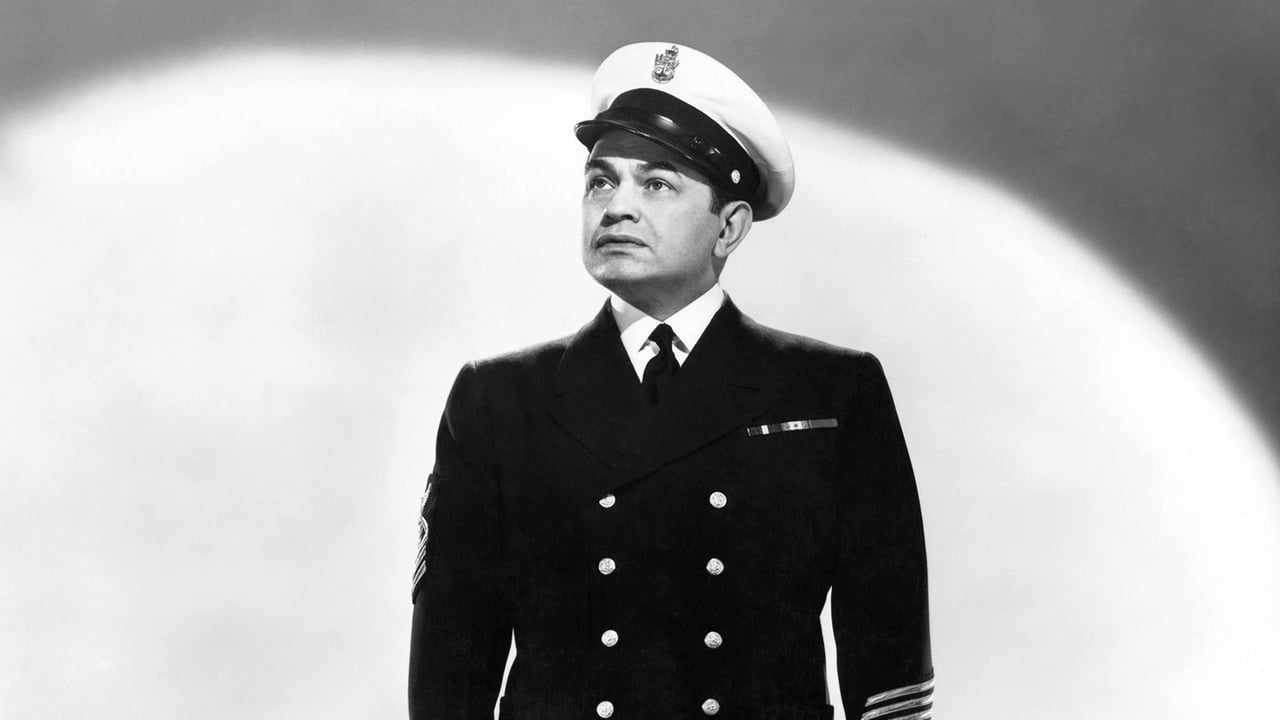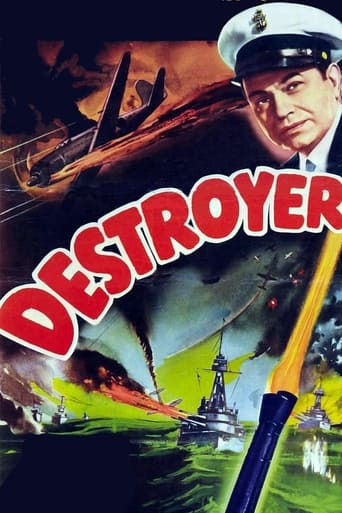

Eddie Robinson is first rate in this film about an old school sailor having to deal with the new kids on the block. I enjoyed seeing the scenes of San Diego boot camp since I went through the now extinct station myself. Glenn Ford is good too. I lost favor with him as he became older but his younger days stuff is good. The only part of the movie I didn't like was that the daughter eloped with Ford. I still think they should have consulted dad. But I guess the writer was trying to say that girls end up marrying the same guy as their father. The scene where Robinson rallies the boys with the story of John Paul Jones is one of the greatest in cinema. It had me balling! All in all, solid.
... View MoreOthers have commented about the fine cast, good acting and relative action in this film. What many viewers – and most or all of the commenters so far – may have missed is that the story and script for "Destroyer" came from Frank "Spig" Wead. Wead had an illustrious Navy career in WWI and later. He was one of the very first Navy fliers and helped promote naval aviation. In 1926, he broke his neck when he fell down the stairs in his family's new home. His surgery was successful, but he had to walk with crutches or a cane the rest of his life. He retired from the Navy and began writing books and screenplays. The latter were mostly about the Navy and most were made into very good movies. When World War II broke out Wead was reactivated and helped with the planning and tactics involving naval aircraft in the Pacific. He went to sea and took part in several naval battles before finally retiring in early 1944. During the war and for several years after, he wrote the screenplays for a number of movies that Hollywood produced. Other big movies based on his books and screenplays include "Wings for Men" in 1931, "Test Pilot" in 1938, "The Citadel" in 1938, "Dive Bomber" in 1941, and "They Were Expendable" in 1945. Wead died at age 52 in 1947 after surgery. MGM produced a movie in 1957 about him, "The Wings of Eagles." John Wayne and Maureen O'Hara played Spig and his wife, Min.Something about this movie, with the fact the Spig Wead wrote the story and screenplay, leads me to believe that there is a subtle message in it. The film came out toward the middle of the war, with two more years to go (although no one could know that at the time). And look at the plot. A new ship is taken out for trial runs and has so many things go wrong that it had to come back for repairs at least three times. We see rivets popping, seams leaking, pipes breaking, motors and other things blowing. As a viewer, I thought that the critics in the movie were right. The ship was a piece of junk – in spite of Edward G. Robinson's pleas to the contrary. And, just think – if that happened with all or many ships, it's a wonder we had a Navy afloat at all to do battle. But that obviously wasn't the case – as the Navy brass ordered the ship to do mail delivery duty because it was unfit for service in the combat fleet. So, this ship just happened to be a lemon, right? Now think back to the opening scenes where Robinson is a civilian working on the crew that is building this new ship. Remember the several instances when he calls different workers to task for cutting corners? He tells one welder that he can't "cold" weld along a seam. The worker says that he can do that, and Robinson says that it would leak and he urges the guy to do it right. We see a few other subtle little scenes like this. I remember thinking that if that's the way the war-time shipbuilding yards were all working, they were sure doing a lot to help the enemy sink our ships. But the volume of records and evidence we have show that our wartime industries and workers took pride in doing their jobs right and well. They knew that the planes, and ships, and tanks, and weapons they were making were for the Americans and other fighting men who were defending freedom and our shores with their lives. They were their sons and brothers, husbands and fathers, uncles and cousins, and boy friends and neighbors. So, the workers took pride in what they did and in doing it right. That's why I think Wead wrote a subtle message into the screenplay – and Columbia kept it in the movie intentionally. It was a message to the home front workers about how important their jobs were and that they needed to do them well. The movie gave a picture of what could happen if the home front workers did sloppy work or cut corners. They would endanger the lives of many fellow Americans. They could cause the loss of ships, aircraft and battles. If you doubt this, watch the movie again, and watch for those instances of shoddy or faulty workmanship that Robinson points out to his fellow workers. And then watch for the problems they have during their trial runs to get the ship battle ready. I'll just bet that the home front workers who saw this movie in 1943 were more than a little upset at what they saw. And if it had been up to them in real life, all those goldbrickers in the movie shipyard would have been canned.
... View MoreFirst Rate for the period. A good patriotic Navy film, in the class with "Men of Honor" and Top Gun. Great depiction of sailors,Ships and the sea. As a U.S. Navy Veteran and "Tin-can-Sailor" an affectionate term for "Destroyer" Sailors, this shows the connection of the men and the Ship. The personality and the Valor of the Ship and her namesake and the men that make HER sail. To the sailor she is more than just steel that floats, she is Life; one lives, eats and sleeps the ship. If she don't float, we die. She takes us in harm's way and if we do it right, she brings us home. Home is the sailor, home from the sea. "Well done "Boli."
... View MoreEdward G. Robinson and Glenn Ford star in Destroyer, a sentimental Navy tale of two different generations of Navy men. Though the film's World War II vintage somewhat dates it, the film is still good entertainment.The film begins with news of the USS John Paul Jones being sunk in the Pacific. That news is particularly hard for retired Navy chief Edward G. Robinson who now makes a living building ships in the navy yard. He gets to build the new John Paul Jones and decides that he ought to serve on her.But when he pulls some strings to get assigned to the JPJ II, someone gets displaced as the chief boatswain. That someone is Glenn Ford and that doesn't make for a harmonious ship. In addition Robinson's kind of behind the times in the newer improvements the US Navy has made since the last war. Complicating things is Marguerite Chapman, Robinson's daughter who Ford falls for. That really makes things bad on shore and off.Robinson's the show in this film. His portrayal of an old Navy fighting man who won't be beached in a second war is sentimental, but effective. His best moments are when he finally begins to win the crew's respect by telling them the story of the guy and the engagement that the guy fought for whom the ship is named after. In fact the final duel between the USS John Paul Jones and a Japanese submarine has a lot of similarity between what happened with the Bonhomme Richard and the Serapis of the Royal Navy. Rounding out a nice supporting cast are Regis Toomey, Edward Brophy, Edgar Buchanan, and Leo Gorcey who gives us a bit of New York street smarts for the ship.Destroyer is a dated propaganda film from the World War II era, but still entertaining because of the two leads.
... View More